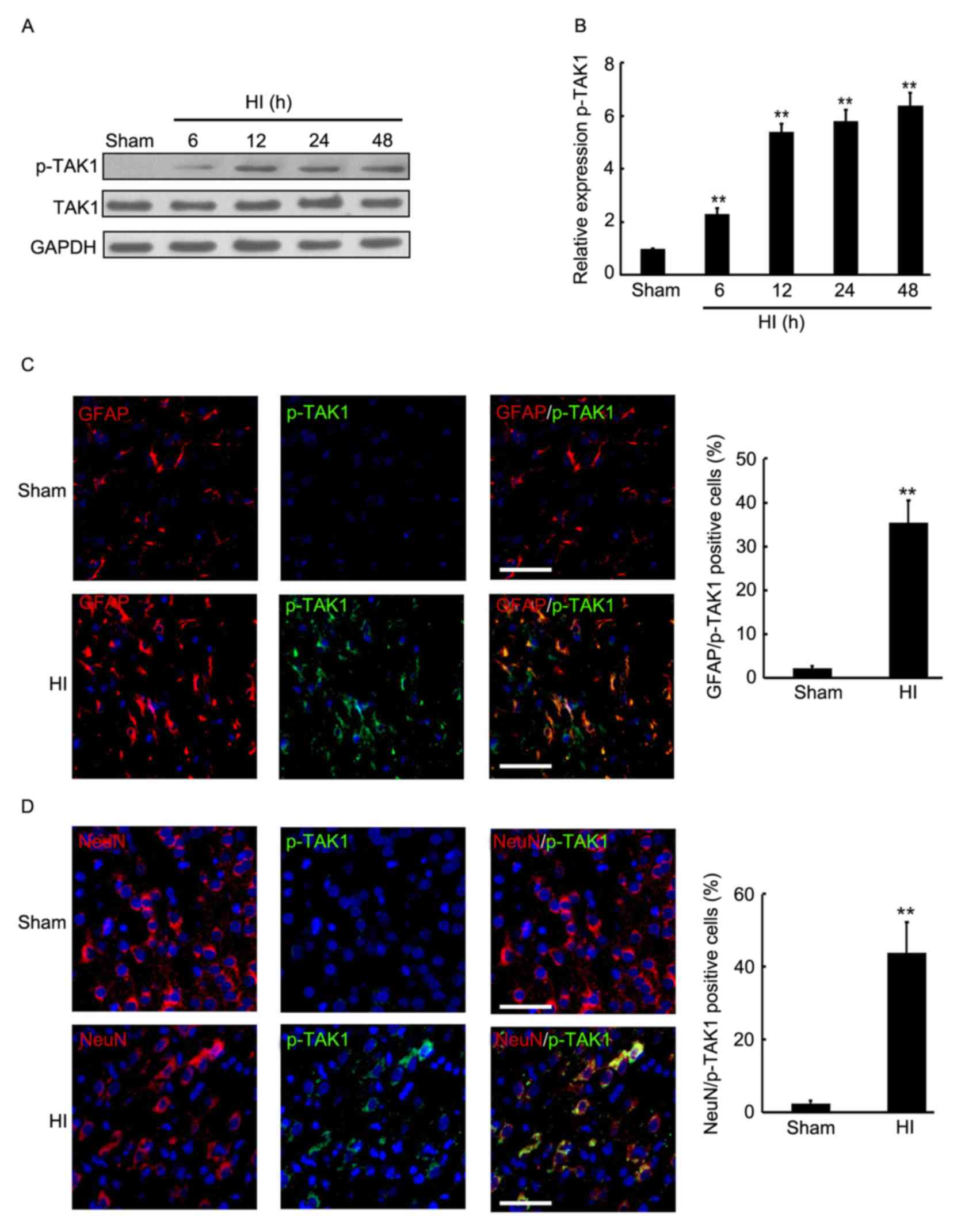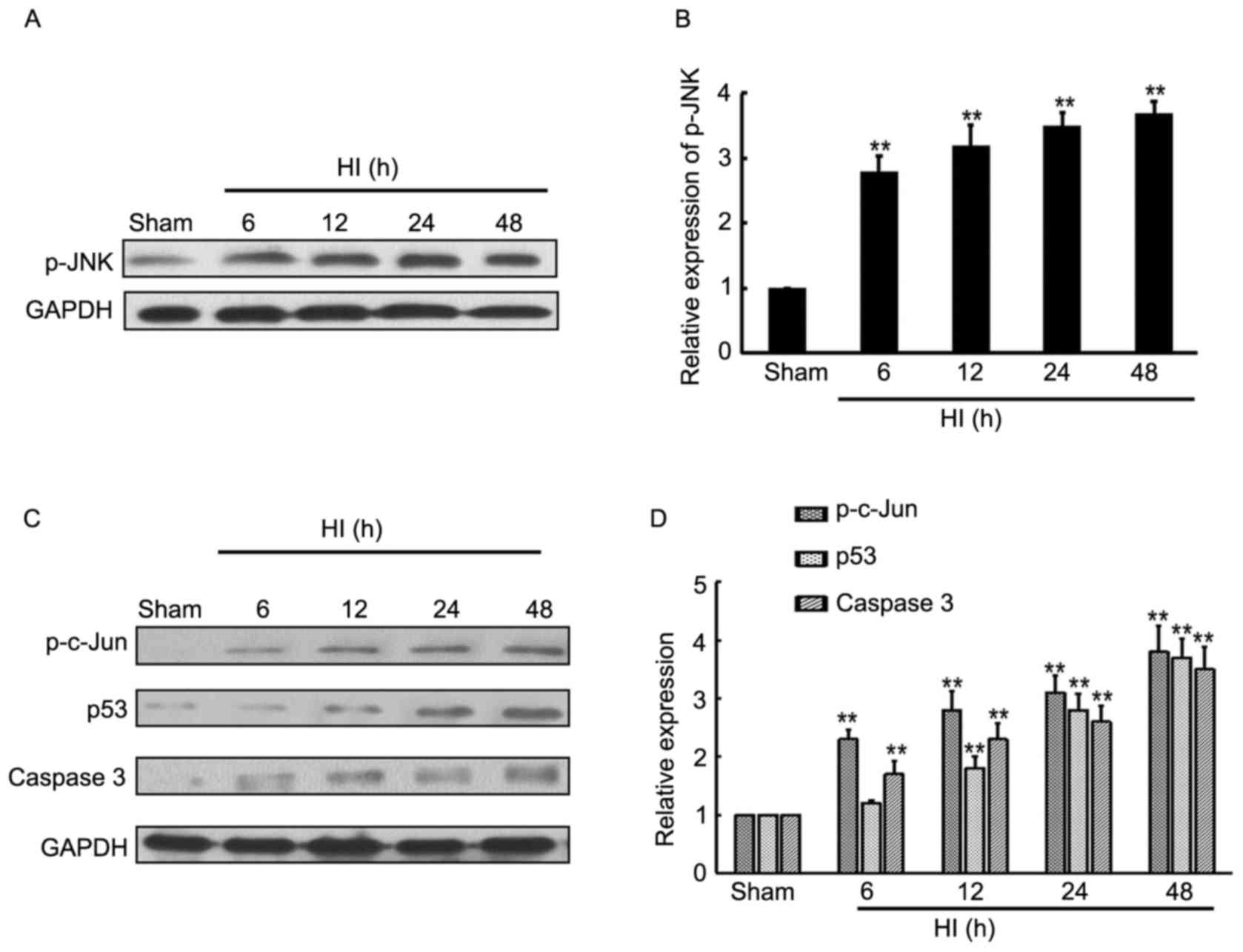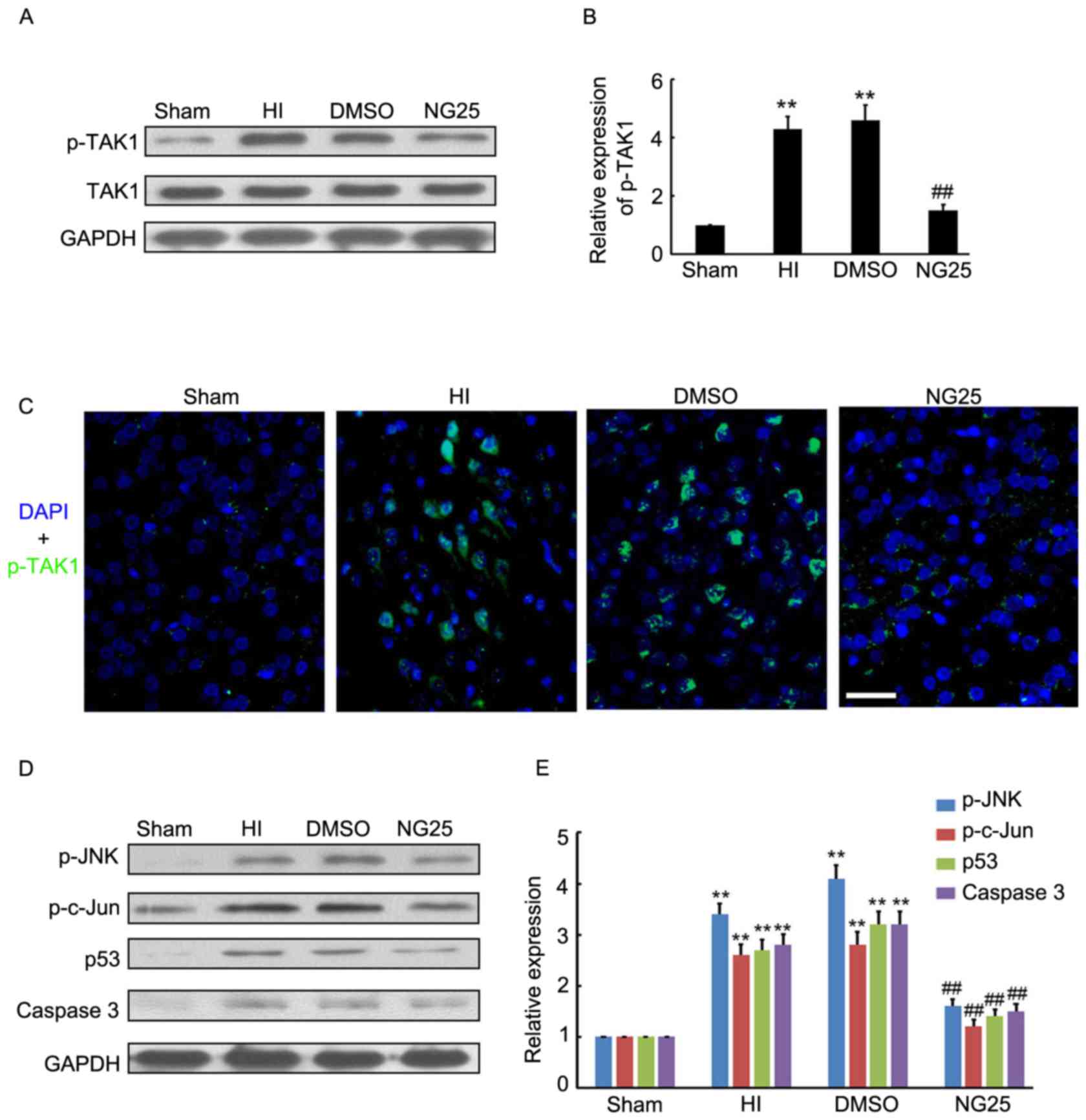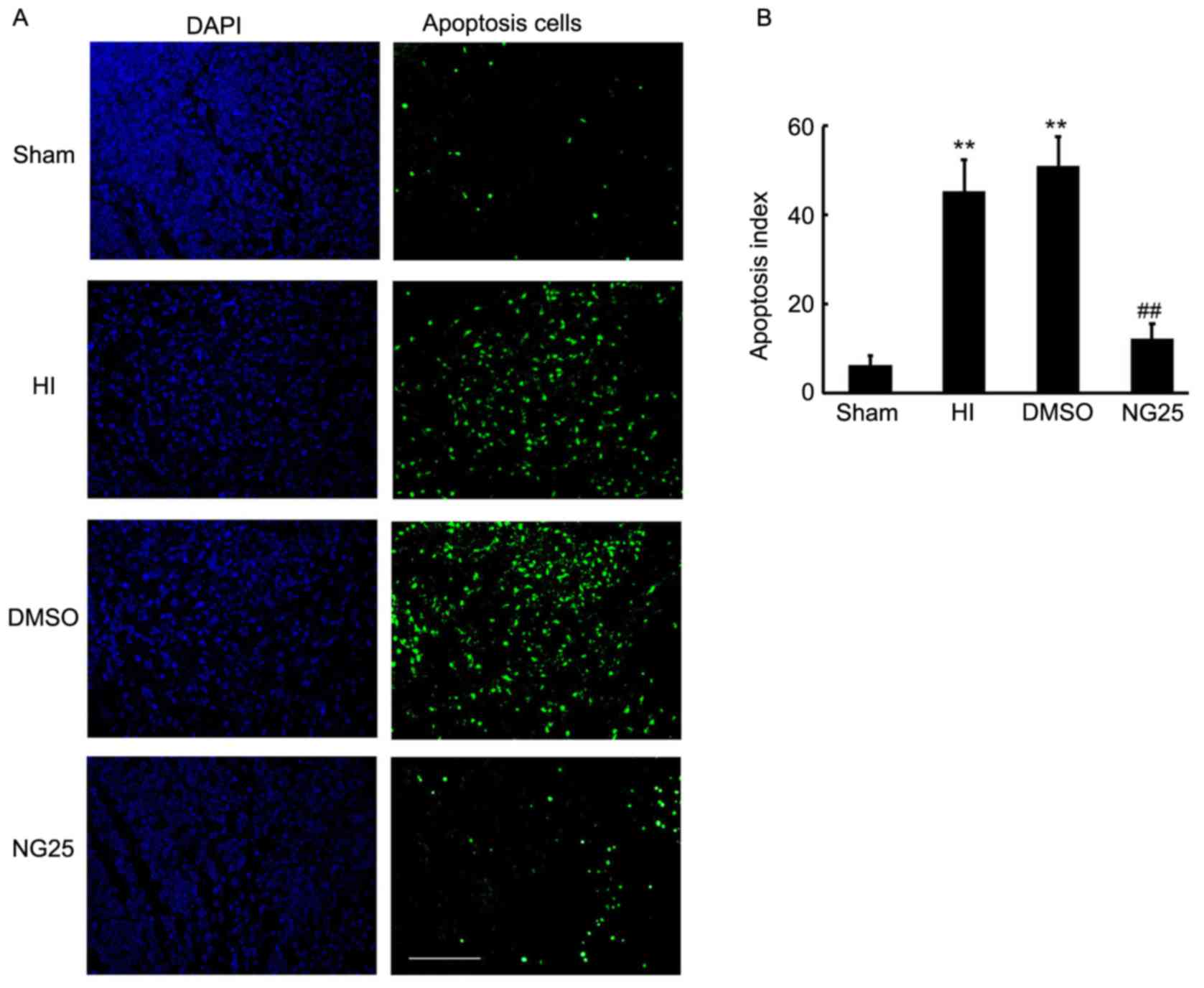NG25, an inhibitor of transforming growth factor‑β‑activated kinase 1, ameliorates neuronal apoptosis in neonatal hypoxic‑ischemic rats
- Authors:
- Published online on: November 10, 2017 https://doi.org/10.3892/mmr.2017.8024
- Pages: 1710-1716
-
Copyright: © Wang et al. This is an open access article distributed under the terms of Creative Commons Attribution License.
Abstract
Introduction
Neonatal hypoxic-ischemic (HI) encephalopathy affects 2–6 out of 1,000 term births in the developed world, associating with high mortality and lifelong chronic disabilities (1,2). HI insult of human neonatal is a vital cause of perinatal brain injury, which may cause cerebral palsy, seizures, learning limitations and epilepsy (3,4). Animal studies have demonstrated that the mechanisms leading to injury in the neonatal brain are distinct from those involved in adult brain injury (5). Apoptosis appears to be prominent in neonatal HI, as this cascade is easily engaged following brain insults during this developmental stage (6,7). Thus, targeting apoptosis may be a useful strategy for HI-induced brain injury.
Transforming growth factor (TGF)-β-activated kinase 1 (TAK1) belongs to the mitogen-activated protein kinases (MAPK) kinase kinase (MAP3K) family (8), and was first found to be activated by TGF-β and bone morphologic proteins (9). TAK1 is essential to activating the IκB kinase (IKK)/nuclear factor (NF)-κB signaling pathways and the stress kinase [c-Jun N-terminal kinases (JNK) and p38 MAPK] signaling pathways in response to various stressors (10). Previous studies have demonstrated that TAK1 is a central regulator of cell death and is activated via a diverse set of intra- and extracellular stimuli (8,11,12). The TAK1-JNK signaling pathway has been demonstrated to be crucial in cell apoptosis; For instance, this pathway is involved in activated T-cell apoptosis in a model of lung and thyroid cancers (11,13–15). Thus, TAK1-JNK signaling pathways have been a widely used therapeutic target in cancer and other types of disease (16–19).
However, the role of TAK1 in the neonatal brain following HI is still unclear. Thus, the expression level and distribution of phosphorylated (p)-TAK1 was investigated, at various time-points following insult, by western blotting and double immunofluorescence. The results demonstrated the presence of p-TAK1, and that it localized with neurons and astrocytes. Further study demonstrated that injection of NG25 prior to insult significantly inhibited TAK1/JNK activity and markedly ameliorated acute hypoxic-ischemic cerebral injury by inhibiting cell apoptosis.
Materials and methods
HI rat model and treatment
The 7-day-ol d rat pups (20 pups, 4 pups in each group, about 20 g) were purchased from the Animal Center of Sichuan University (Chengdu, China) and on a 12-h night/12-h day cycle at a room temperature of 22±2°C with free access to food and water. Each group of four pups were kept in one feeding box. Then, the pups were used for establishing the HI model. Briefly, the pups were anesthetized with diethylether (0.1 mg/kg) and the body was maintained at 37°C using a homoisothermy bench. A skin incision (0.5 cm) was made in the midline of the neck and the right common carotid artery (CCA) was permanently ligatured using 5–0 silk. Following ligation of the CCA, the pups were returned to the dam for 0.5 h to recover from anesthesia. The pups were placed in a chamber at a constant 37°C for hypoxia (8% O2, 92% N2) for 6, 12, 24 and 48 h. The sham group underwent a neck dissection and the 5–0 silk was placed around the CCA, but was not ligated. All animal procedures were approved by Sichuan University Committee (Chengdu, China) on Animal Use and Care, and all efforts were made to minimize animal suffering and the number of animals sacrificed.
NG25 (MedChem Express, Monmouth Junction, NJ, USA), a highly specific TAK1 inhibitor, was dissolved in Sigma-Aldrich dimethyl sulfoxide (DMSO; Merck KGaA, Darmstadt, Germany) and injected into the right cerebral hemisphere 30 min prior to HI using a 30-gauge needle with a 5-µl Hamilton syringe (infusion rate, 1 µl/min).
Immunofluorescence
At different designated time-points, the brains were perfused and fixed in 4% paraformaldehyde for 48 h. Then the brains were embedded in paraffin and sectioned (thickness, 4 mm). The sections were probed with p-TAK1 primary antibody (cat no. 9339, 1:200; Cell Signaling Technology, Inc., Danvers, MA, USA) and mouse monoclonal antibodies against NeuN (cat no. MAB377, 1:150) or glial fibrillary acidic protein (GFAP; cat no. MAB360, 1:80) (both from EMD Millipore, Billerica, MA, USA) and followed by incubation (37°C) with a 1:120 dilution of a secondary antibody; either fluorescein isothiocyanate- or tetramethylrhodamine-conjugated anti-rabbit (cat no. sc-2012) or anti-mouse (cat no. sc-2010) IgG (Santa Cruz Biotechnology, Inc., Dallas, TX, USA). The nucleus was stained with 4′,6-diamidino-2-phenylindole (DAPI). Five sections per rat were imaged by a fluorescence microscope (DTX500; Nikon Corporation, Tokyo, Japan) and analyzed.
Western blot analysis
Cell extracts were prepared using a RIPA lysis buffer (Beyotime Institute of Biotechnology, Haimen, China). At different time-points after HI treatment, the cortex and hippocampus from the right hemisphere were collected and dissected (n=3 per group). The cortex extracts were prepared in the RIPA lysis buffer containing a protease inhibitor cocktail (Merck KGaA). Protein concentrations were determined using a BCA protein assay kit (Beyotime Institute of Biotechnology) with bovine serum albumin serving as the standard. Protein samples (20 µg per lane) were resolved on 10% SDS-PAGE and transferred (100V, 50 min) to polyvinylidene fluoride membranes (EMD Millipore). The membranes were blocked in 5% nonfat milk in tris-buffered saline containing 0.05% Tween-20 for 1 h at room temperature and immunoblotted with various antibodies as follows: p-TAK1 (cat no. 9339, 1:1,000); rabbit anti-TAK1 monoclonal antibody (cat no. 5206, 1:800); rabbit anti-p-JNK (Thr183/Tyr185) polyclonal antibody (cat no. 9255, 1:1,000); rabbit anti-p-c-Jun polyclonal antibody (cat no. 3270, 1:800) (all from Cell Signaling Technology, Inc.); rabbit anti-p53 polyclonal antibody (cat no. ab26, 1:200; Abcam, Cambridge, MA, USA); and rabbit anti-caspase-3 polyclonal antibody (cat no. C9598, 1:100; Sigma-Aldrich; Merck KGaA) overnight at 4°C. A rabbit anti-GAPDH polyclonal antibody (cat no. G9545, 1:2,000; Sigma-Aldrich; Merck KGaA) served as an internal loading control. The bound antibodies were visualized with horseradish peroxidase-conjugated antibodies against rabbit or mouse IgG using the electrochemiluminescence (ECL) or ECL advance western blotting detection kit (Merck KGaA). Image-Pro Plus (version 6.0; Media Cybernetics, Inc., Rockville, MD, USA) was used to quantify the densities of the protein signals on X-ray films following scanning.
TUNEL assay
To detect apoptotic cells in tumor tissue samples, TUNEL assay using a DeadEnd™ Fluorometric TUNEL system (Promega Corporation, Madison, WI, USA) was performed according to the manufacturer's protocol. Cell nuclei with dark green fluorescent staining were defined as apoptotic cells. To quantify TUNEL-positive cells, the number of green fluorescence-positive cells was imaged by a fluorescence microscope (DTX500; Nikon Corporation, Tokyo, Japan) and counted in five random fields. Cell nuclei were counterstained with DAPI.
Statistical analysis
Statistical analysis was performed using SPSS version 19.0 (SPSS, Inc., Chicago, IL, USA). Numerical continuous data are presented as the mean ± standard deviation and analyzed using one-way analysis of variance. P<0.05 was considered to indicate a statistically significant difference.
Results
Induction of TAK1 phosphorylation in the brain cortex of rats with HI
To determine the expression of p-TAK1 in the brain cortex of rats with HI, the hemispheres of rats were collected at different time-point post HI treatment and used for western blotting. As presented in Fig. 1A and B, a significant increase of p-TAK1 expression was observed in the brain cortex 6 h after insult, followed by a 2-6-fold increase in p-TAK1 protein expression in the brain of the HI model compared with that of the sham group at 6, 12, 24 and 48 h. Subsequently, double immunofluorescence was employed to detect the expression and distribution of p-TAK1 in the rat cortex of sham control and experimental group rats (24 h after HI). Furthermore, the neuronal-specific marker, NeuN and the astrocyte-specific marker, GFAP were used to indicate the neurons and astrocytes. As demonstrated in Fig. 1C, compared with the sham group, an increased expression level of p-TAK1 was observed, which was localized with astrocytes at 24 h after insult. NeuN and p-TAK1 double immunofluorescence indicate that a greater expression level of p-TAK1 was observed and localized with neurons at 24 h after insult, compared with the sham group (Fig. 1D). Thus, induction of p-TAK1 was observed in the brain cortex of rats with HI, and p-TAK1 was expressed by astrocytes and neurons.
Induction of TAK1 downstream target expression in the brain cortex of HI model rats
JNK is the direct target of TAK1, thus western blotting was employed to determine the expression level of p-JNK at different time-points in the rat cortex following HI. The current results indicate that HI treatment induced p-JNK expression from 6–48 h after insult, compared with the sham control rats (Fig. 2A and B), whereas there were no significant effects on total JNK expression (data not shown). Furthermore, the JNK-associated downstream targets, p-c-Jun, p53 and caspase-3 expression levels were determined by western blotting. The results demonstrate that p-c-Jun, p53 and caspase-3 expression levels were significantly increased from 6–48 h after insult, compared with the sham control rats (Fig. 2C and D).
NG25 inhibits p-JNK and downstream target expression levels in the brain cortex of HI model rats
To further determine the potential neuroprotective role of TAK1 silencing on HI-induced brain injury, NG25, an inhibitor of p-TAK1, was injected into the rat brains prior to HI treatment. The results demonstrated that NG25 markedly inhibited p-TAK1 expression in the brain cortex, compared with the HI and DMSO groups (Fig. 3A and B). Further immunofluorescence staining indicated that p-TAK1 expression was inhibited by NG25 in the brain cortex (Fig. 3C). Western blotting indicated that p-JNK, p-c-Jun, p53 and caspase-3 expression levels were significantly decreased by NG25 in the brain cortex, compared with the HI and DMSO group (Fig. 3D and E). Thus, the inhibitory role of NG25 on p-TAK1 and associated downstream target expression levels was demonstrated.
NG25 ameliorates neuronal apoptosis in the brain cortex
Apoptosis is the major cause of brain injury subsequent to HI. The TAK1-JNK signaling pathway is a well-known inductor of apoptosis and has been widely researched in tumors (13–15). Thus, in the current study, TUNEL staining was employed to detect the apoptotic cells in the brain cortex. As shown in Fig. 4A, an increased number of apoptotic cells were observed in the HI and DMSO-treated rats, when compared with the sham control rats (Fig. 4B). Notably, less apoptosis was observed in the NG25 injection group when compared with the HI and DMSO-treated group (Fig. 4). Thus, our results indicated that knockdown of TAK1 by NG25 markedly inhibited apoptosis in the brain cortex.
Discussion
The aim of the present study was to determine whether, and how, TAK1 affects HI-induced brain injury in neonatal rats. Thus, a HI model was established in 7-day-old rats, and the expression and distribution of p-TAK1 was investigated at different time-points following insult. p-TAK1 expression in the developing brain was observed to be induced following HI, indicating that it is involved in the development of HI-induced brain injury. Furthermore, the inhibition of p-TAK1 expression with the specific inhibitor, NG25 significantly alleviated the HI-induced brain injury and apoptosis by preventing TAK1-JNK signaling pathway activity. The results indicate that TAK1 is a potential therapeutic target for neonatal HI-induced brain injury.
Various studies have indicated that apoptosis is crucial during the development of HI-induced brain injury (20). An experimental study in neonatal models has demonstrated that the extent of apoptosis-inducing factor translocation to the nucleus correlates with the morphological distribution of neuronal injury following hypoxia-ischemia (21). In addition, gene deletion of poly(ADP-ribose) polymerase-1 and cyclophilin A significantly decreases apoptosis-inducing factor translocation to the nucleus, which is accompanied by the reduction of brain injury (22,23). Thus, apoptosis deficiency confers considerable protection for neonatal HI-induced brain injury (24,25). In the present study, the inhibitory role of NG25 on brain apoptosis in neonatal HI was demonstrated and the protective role of NG25 on HI-induced brain injury in neonatal rats was further indicated.
The role of TAK1 inhibition on preventing neuronal death following ischemia has been demonstrated in previous studies (26–28). However, only the role of TAK1 inhibition on adult mice and rats was investigated (26–28). Notably, neonatal HI encephalopathy affects 2–6 out of 1,000 term births in the developed world, which is associated with high mortality and lifelong chronic disabilities (1,2). Thus, further work is required to develop novel strategies for neonatal HI therapy. In the current study, the expression and function of TAK1 in neonatal HI rats was the focus, and 7-day-old pups were used to establish the HI model and undergo treatment. The study demonstrated that inhibition of TAK1 efficiency ameliorated neuronal apoptosis in the neonatal HI rats.
JNKs are important stress responsive kinases that are activated by various forms of insults, including oxidative stress and ischemia. JNK activation precedes cell death by apoptosis and inflammation in many cell types (29). It has been shown that JNK hyperactivation in neurons, microglia and vascular endothelial cells is important in overweight-aggravated HI injury in the neonatal brain (30). A previous study demonstrated that the JNK/forkhead box O3/Bim signaling pathway is involved in neuronal apoptosis in the developing rat brain following HI and that agents targeting JNK may potentially protect neurons from HI-induced damage (31). In another study, the JNK/activator protein 1 signaling pathway participated in neuronal apoptosis in the neonatal rat brain following HI, and inhibition of JNK with D-JNKi or TAT-JBD efficiently protects the neonatal brain against ischemic brain damage and subsequent cognitive and motor impairment (32,33). Thus, JNK is a widely used therapeutic target for neonatal HI-induced brain injury. In the present study, JNK hyperactivation was observed in the neurons following HI, which is consistent with previous studies (30–33). As predicted, knockdown of p-TAK1 with NG25 significantly inhibited p-JNK expression levels and the associated downstream target expression. NG25, widely used in recent studies (34,35), was injected with a lower dose into rats in the current study, as compared with the 5Z-7-oxozeaenol that was used in the previous study (28); a lower dose of molecular compound causes fewer side effects. The current study indicates that NG25 serves the neuroprotective role in the developing brain following insult by inhibiting the activity of JNK and the associated brain apoptosis.
In conclusion, the present results indicate that TAK1 is involved in the development of neonatal HI-induced brain injury. To the best of our knowledge, the present study is the first to demonstrate that knockdown of p-TAK1, via intracerebroventricular injection of NG25 (a specific inhibitor of TAK1), prior to insult significantly attenuates acute HI cerebral injury by inhibiting JNK signaling pathway activity and the associated brain apoptosis. Thus, TAK1 is proposed as a potential therapeutic target for the treatment of neonatal HI-induced brain injury. Further study are needed to determine the long term validity and the potential toxicity of NG25.
Acknowledgements
The present study was supported by the National Science Foundation of China (grant no. 81401239).
References
|
Wachtel EV and Hendricks-Muñoz KD: Current management of the infant who presents with neonatal encephalopathy. Curr Probl Pediatr Adolesc Health Care. 41:132–153. 2011. View Article : Google Scholar | |
|
Selway LD: State of the science: Hypoxic ischemic encephalopathy and hypothermic intervention for neonates. Adv Neonatal Care. 10:60–68. 2010. View Article : Google Scholar | |
|
Robertson CM, Finer NN and Grace MG: School performance of survivors of neonatal encephalopathy associated with birth asphyxia at term. J Pediatr. 114:753–760. 1989. View Article : Google Scholar | |
|
Marlow N, Rose AS, Rands CE and Draper ES: Neuropsychological and educational problems at school age associated with neonatal encephalopathy. Arch Dis Child Fetal Neonatal Ed. 90:F380–F387. 2005. View Article : Google Scholar : | |
|
Back SA, Han BH, Luo NL, Chricton CA, Xanthoudakis S, Tam J, Arvin KL and Holtzman DM: Selective vulnerability of late oligodendrocyte progenitors to hypoxia-ischemia. J Neurosci. 22:455–463. 2002. | |
|
Li L, Klebe D, Doycheva D, McBride DW, Krafft PR, Flores J, Zhou C, Zhang JH and Tang J: G-CSF ameliorates neuronal apoptosis through GSK-3β inhibition in neonatal hypoxia-ischemia in rats. Exp Neurol. 263:141–149. 2015. View Article : Google Scholar | |
|
Xiao Q, Ford AL, Xu J, Yan P, Lee KY, Gonzales E, West T, Holtzman DM and Lee JM: Bcl-x pre-mRNA splicing regulates brain injury after neonatal hypoxia-ischemia. J Neurosci. 32:13587–13596. 2012. View Article : Google Scholar : | |
|
Mihaly SR, Ninomiya-Tsuji J and Morioka S: TAK1 control of cell death. Cell Death Differ. 21:1667–1676. 2014. View Article : Google Scholar : | |
|
Yamaguchi K, Shirakabe K, Shibuya H, Irie K, Oishi I, Ueno N, Taniguchi T, Nishida E and Matsumoto K: Identification of a member of the MAPKKK family as a potential mediator of TGF-beta signal transduction. Science. 270:2008–2011. 1995. View Article : Google Scholar | |
|
Sato S, Sanjo H, Takeda K, Ninomiya-Tsuji J, Yamamoto M, Kawai T, Matsumoto K, Takeuchi O and Akira S: Essential function for the kinase TAK1 in innate and adaptive immune responses. Nat Immunol. 6:1087–1095. 2005. View Article : Google Scholar | |
|
Hirata Y, Sugie A, Matsuda A, Matsuda S and Koyasu S: TAK1-JNK axis mediates survival signal through Mcl1 stabilization in activated T cells. J Immunol. 190:4621–4626. 2013. | |
|
Wang JS, Wu D, Huang DY and Lin WW: TAK1 inhibition-induced RIP1-dependent apoptosis in murine macrophages relies on constitutive TNF-α signaling and ROS production. J Biomed Sci. 22:762015. View Article : Google Scholar : | |
|
Augeri DJ, Langenfeld E, Castle M, Gilleran JA and Langenfeld J: Inhibition of BMP and of TGFβ receptors downregulates expression of XIAP and TAK1 leading to lung cancer cell death. Mol Cancer. 15:272016. View Article : Google Scholar : | |
|
Lin P, Niu W, Peng C, Zhang Z and Niu J: The role of TAK1 expression in thyroid cancer. Int J Clin Exp Pathol. 8:14449–14456. 2015. | |
|
Okada M, Matsuzawa A, Yoshimura A and Ichijo H: The lysosome rupture-activated TAK1-JNK pathway regulates NLRP3 inflammasome activation. J Biol Chem. 289:32926–32936. 2014. View Article : Google Scholar : | |
|
Bao D, Lu D, Liu N, Dong W, Lu YD, Qin C and Zhang LF: Tomoregulin-1 prevents cardiac hypertrophy after pressure overload in mice by inhibiting TAK1-JNK pathways. Dis Model Mech. 8:795–804. 2015. View Article : Google Scholar : | |
|
Fan Y, Cheng J, Vasudevan SA, Patel RH, Liang L, Xu X, Zhao Y, Jia W, Lu F, Zhang H, et al: TAK1 inhibitor 5Z-7-oxozeaenol sensitizes neuroblastoma to chemotherapy. Apoptosis. 18:1224–1234. 2013. View Article : Google Scholar : | |
|
Hayakawa Y, Hirata Y, Kinoshita H, Sakitani K, Nakagawa H, Nakata W, Takahashi R, Sakamoto K, Maeda S and Koike K: Differential roles of ASK1 and TAK1 in Helicobacter pylori-induced cellular responses. Infect Immun. 81:4551–4560. 2013. View Article : Google Scholar : | |
|
Ikeda Y, Morioka S, Matsumoto K and Ninomiya-Tsuji J: TAK1 binding protein 2 is essential for liver protection from stressors. PLoS One. 9:e880372014. View Article : Google Scholar : | |
|
Hagberg H, Mallard C, Rousset CI and Xiaoyang W: Apoptotic mechanisms in the immature brain: Involvement of mitochondria. J Child Neurol. 24:1141–1146. 2009. View Article : Google Scholar : | |
|
Zhu C, Qiu L, Wang X, Hallin U, Candé C, Kroemer G, Hagberg H and Blomgren K: Involvement of apoptosis-inducing factor in neuronal death after hypoxia-ischemia in the neonatal rat brain. J Neurochem. 86:306–317. 2003. View Article : Google Scholar | |
|
Hagberg H, Wilson MA, Matsushita H, Zhu C, Lange M, Gustavsson M, Poitras MF, Dawson TM, Dawson VL, Northington F and Johnston MV: PARP-1 gene disruption in mice preferentially protects males from perinatal brain. J Neurochem. 90:1068–1075. 2004. View Article : Google Scholar | |
|
Zhu C, Wang X, Deinum J, Huang Z, Gao J, Modjtahedi N, Neagu MR, Nilsson M, Eriksson PS, Hagberg H, et al: Cyclophilin A participates in the nuclear translocation of apoptosis-inducing factor in neurons after cerebra l hypoxia-ischemia. J Exp Med. 204:1741–1748. 2007. View Article : Google Scholar : | |
|
Gu Y, Zhang Y, Bi Y, Liu J, Tan B, Gong M, Li T and Chen J: Mesenchymal stem cells suppress neuronal apoptosis and decrease IL-10 release via the TLR2/NFkB pathway in rats with hypoxic-ischemic brain damage. Mol Brain. 8:652015. View Article : Google Scholar : | |
|
Sun MY, Cui KJ, Yu MM, Zhang H, Peng XL and Jiang H: Bax inhibiting peptide reduces apoptosis in neonatal rat hypoxic-ischemic brain damage. Int J Clin Exp Pathol. 8:14701–14708. 2015. | |
|
Neubert M, Ridder DA, Bargiotas P, Akira S and Schwaninger M: Acute inhibition of TAK1 protects against neuronal death in cerebral ischemia. Cell Death Differ. 18:1521–1530. 2011. View Article : Google Scholar : | |
|
White BJ, Tarabishy S, Venna VR, Manwani B, Benashski S, McCullough LD and Li J: Protection from cerebral ischemia by inhibition of TGFβ-activated kinase. Exp Neurol. 237:238–245. 2012. View Article : Google Scholar : | |
|
Zhang D, Hu Y, Sun Q, Zhao J, Cong Z, Liu H, Zhou M, Li K and Hang C: Inhibition of transforming growth factor beta-activated kinase 1 confers neuroprotection after traumatic brain injury in rats. Neuroscience. 238:209–217. 2013. View Article : Google Scholar | |
|
Cao J, Semenova MM, Solovyan VT, Han J, Coffey ET and Courtney MJ: Distinct requirements for p38alpha and c-Jun N-terminal kinase stress-activated protein kinases in different forms of apoptotic neuronal death. J Biol Chem. 279:35903–35913. 2004. View Article : Google Scholar | |
|
Tu YF, Tsai YS, Wang LW, Wu HC, Huang CC and Ho CJ: Overweight worsens apoptosis, neuroinflammation and blood-brain barrier damage after hypoxic ischemia in neonatal brain through JNK hyperactivation. J Neuroinflammation. 8:402011. View Article : Google Scholar : | |
|
Li D, Li X, Wu J, Li J, Zhang L, Xiong T, Tang J, Qu Y and Mu D: Involvement of the JNK/FOXO3a/Bim pathway in neuronal apoptosis after Hypoxic-Ischemic brain damage in neonatal rats. PLoS One. 10:e01329982015. View Article : Google Scholar : | |
|
Nijboer CH, Bonestroo HJ, Zijlstra J, Kavelaars A and Heijnen CJ: Mitochondrial JNK phosphorylation as a novel therapeutic target to inhibit neuroinflammation and apoptosis after neonatal ischemic brain damage. Neurobiol Dis. 54:432–444. 2013. View Article : Google Scholar | |
|
Nijboer CH, van der Kooij MA, van Bel F, Ohl F, Heijnen CJ and Kavelaars A: Inhibition of the JNK/AP-1 pathway reduces neuronal death and improves behavioral outcome after neonatal hypoxic-ischemic brain injury. Brain Behav Immun. 24:812–821. 2010. View Article : Google Scholar | |
|
Tan L, Nomanbhoy T, Gurbani D, Patricelli M, Hunter J, Geng J, Herhaus L, Zhang J, Pauls E, Ham Y, et al: Discovery of type II inhibitors of TGFβ-activated kinase 1 (TAK1) and mitogen-activated protein kinase kinase kinase kinase 2 (MAP4K2). J Med Chem. 58:183–196. 2015. View Article : Google Scholar | |
|
Wang Z and Zhang H, Shi M, Yu Y, Wang H, Cao WM, Zhao Y and Zhang H: TAK1 inhibitor NG25 enhances doxorubicin-mediated apoptosis in breast cancer cells. Sci Rep. 6:327372016. View Article : Google Scholar : |













